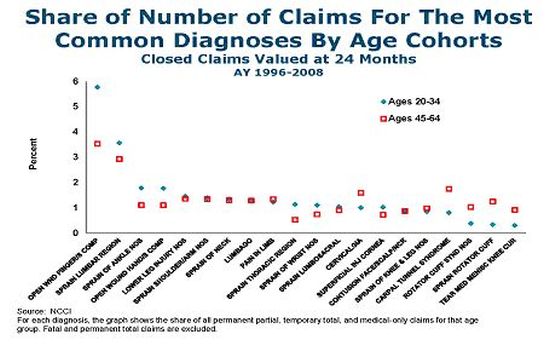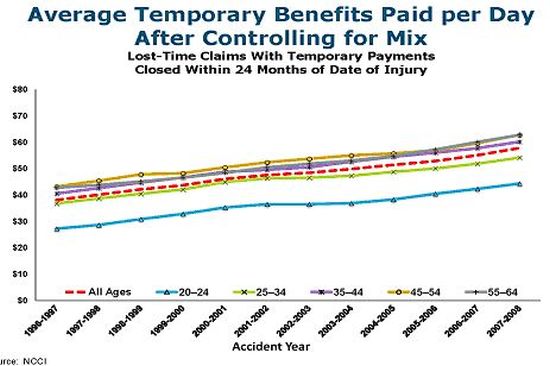
With 35 the new definition of older worker, it's time to focus on reducing injuries for everyone
It's common knowledge that the workforce is getting older and people are retiring later than ever before. This trend has been a major concern for those in the health and safety field because it's generally believed that older workers abilities decline and they are prone to suffer very expensive injuries.
However, recent research from the National Council on Compensation Insurance (NCCI) has cast doubt on this conventional wisdom, or at the very least potentially changed the definition of "older workers".

NCCI studied different age groups and the rate at which they get injured. They found younger workers (under 35) had substantially more cuts on their fingers and older workers (over 35) suffer more cases of carpal tunnel and more cervical injuries, although the numbers are startlingly similar.
So, that quiets the argument about the aging workforce causing more injuries, but what about cost? The research shows that there is a substantial cost difference between younger and older workers, but the split isn't necessarily where you might expect it.

Workers between the ages of 20-24 create much lower costs (and fewer days out), but once workers reach 35, the costs of their injuries are very similar to older workers.
What does this all mean? To start with, it now largely redefines an "older worker" as someone who grew up listening to disco instead of Elvis. This means that someone over 35, not just someone belonging to the traditional "over 65" group, is now being classified as an "older worker." It should also prompt businesses to strongly focus on the things that can reduce injury costs for everyone.
Injury prevention for employees should begin before they even become employees-- during the hiring process. Start with a written functional description for the position that is open. Once that is complete, it is critical that the selected candidate be given a conditional offer of employment. This document is a bona fide job offer with the caveat that it can be withdrawn if the applicant is physically or mentally unable to do the job with reasonable accommodation. Once this is complete, have the candidate go to the doctor and complete a post-offer, pre-placement medical questionnaire. This allows a physician to ask questions relevant to the job and to let the employer know whether or not the candidate is fit for the job. If the candidate is fit, it's time to get started. If not, it's time to find another suitable candidate.
Once an employee is on the job, proper training should instill a constant focus on how to do their job safely. Far more injuries are caused by unsafe acts by employees than unsafe conditions in the workplace. Employees that feel rushed are more likely to set safety aside to meet a deadline, resulting in accidents that could have been prevented.
While having a workforce that is fit for work and doing the job safely will minimize accidents, it's essential that employees know what to do if an accident occurs.
Employees must know before they get hurt whom they should talk to when they suffer an injury. Immediate injury reporting is a key to keeping injury costs as low as possible. Studies have shown that the costs of an injury go up when there is a delay in reporting. Make it your policy that any employee injury is reported before the end of the shift.
Once the injury is reported, getting the proper treatment quickly is key. The best approach is to have a relationship with an occupational medical provider. Board certified occupational doctors can be found on the web at acoem.org. Even if there isn't an occupational medicine specialist nearby, a relationship with a local physician who understands the value of return to work can be helpful.
A relationship with a Workers' Comp specialist medical provider ensures that the doctor knows the business, the physical demands of the job and the nature of transitional work available. When a doctor knows that an employee can go back to work on transitional duty, it's more likely the employee will return to work rather than stay at home to sit on the couch and watch infomercials for attorneys at 1-800-SUE-THEM.
When back at work, an employee is less likely to hire an attorney and more likely to work hard to get back to the full duty position. This process not only gets employees back to work more quickly, it also reduces the amount of money that the insurance company spends on employee injuries, reducing the Experience Mod and therefore Workers' Compensation costs.
The workforce is getting older and employers need to be mindful of accommodations that older workers may need today that they didn't need before. However, NCCI's research should sharpen employers' focus on what can drive down injury rates and costs, including hiring the right people, training them to do their jobs safely, reporting accidents immediately and developing relationships with occupational physicians who will send them back to work, rather than send them home.
If employers follow these steps, having older, experienced workers on the payroll can be a great asset rather than a potential liability.